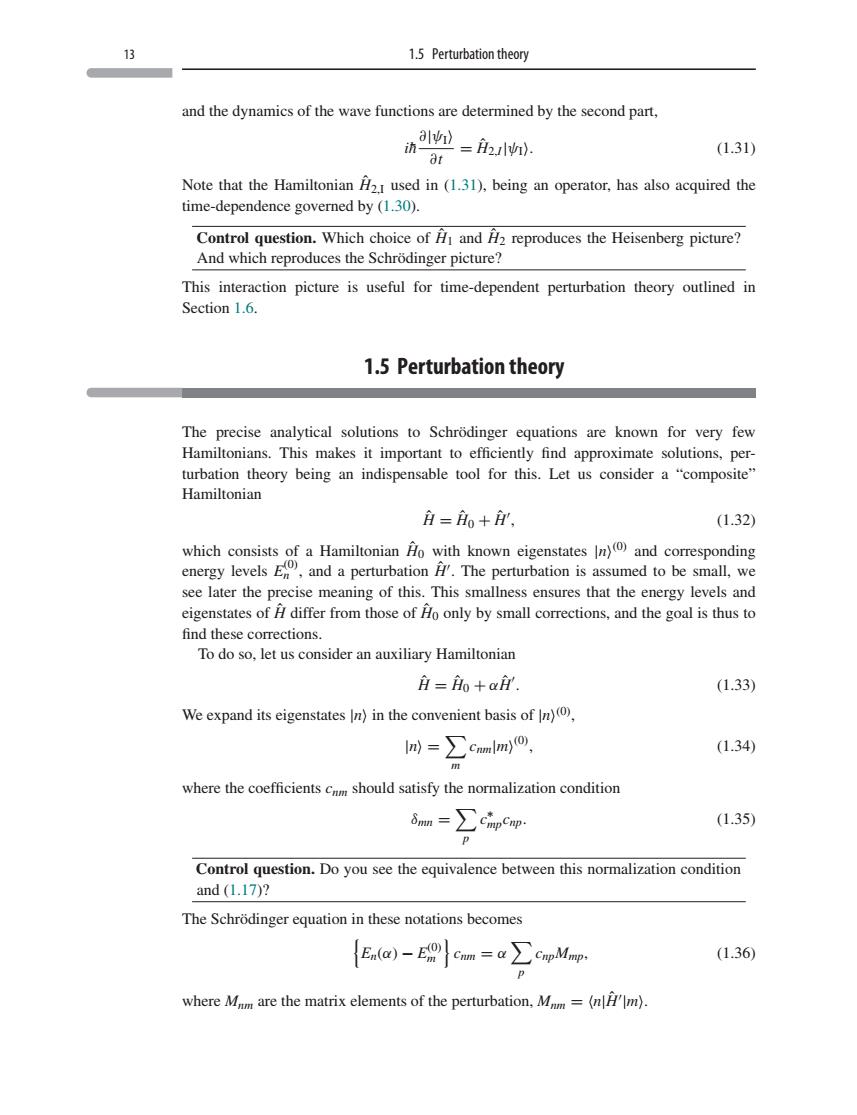正在加载图片...

13 1.5 Perturbation theory and the dynamics of the wave functions are determined by the second part h恤= (1.31) Note that the Hamiltonian A used in (1.31).being an operator,has also acquired the time-dependence governed by(1.30). Control question.Which choice of H and A2 reproduces the Heisenberg picture? And which reproduces the Schrodinger picture? This interaction picture is useful for time-dependent perturbation theory outlined in Section 1.6. 1.5 Perturbation theory equations are known for very few turbation theory being an indispensable tool for this.Let us consider a"composite" Hamiltonian =0+ (1.32 anry leumhe puram he ma e see later the precise meaning of this.This smallness ensures that the energy levels and to those of ony by mceonand the To do so,let us consider an auxiliary Hamiltonian A=Ho+aA' (1.33) We expand its eigenstates in the convenient basis of (1.34 where the coefficients cm should satisfy the normalization condition dnm=∑cncm (1.35 Control and(1.l7)2 The Schrodinger equation in these notations becomes {Ea(a)-E9om=a∑CnpMmp (1.36) where Mm are the matrix elements of the perturbation.Mm=(nAm) 13 1.5 Perturbation theory and the dynamics of the wave functions are determined by the second part, ih¯ ∂|ψI ∂t = Hˆ 2,I|ψI. (1.31) Note that the Hamiltonian Hˆ 2,I used in (1.31), being an operator, has also acquired the time-dependence governed by (1.30). Control question. Which choice of Hˆ 1 and Hˆ 2 reproduces the Heisenberg picture? And which reproduces the Schrödinger picture? This interaction picture is useful for time-dependent perturbation theory outlined in Section 1.6. 1.5 Perturbation theory The precise analytical solutions to Schrödinger equations are known for very few Hamiltonians. This makes it important to efficiently find approximate solutions, perturbation theory being an indispensable tool for this. Let us consider a “composite” Hamiltonian Hˆ = Hˆ 0 + Hˆ , (1.32) which consists of a Hamiltonian Hˆ 0 with known eigenstates |n(0) and corresponding energy levels E(0) n , and a perturbation Hˆ . The perturbation is assumed to be small, we see later the precise meaning of this. This smallness ensures that the energy levels and eigenstates of Hˆ differ from those of Hˆ 0 only by small corrections, and the goal is thus to find these corrections. To do so, let us consider an auxiliary Hamiltonian Hˆ = Hˆ 0 + αHˆ . (1.33) We expand its eigenstates |n in the convenient basis of |n(0), |n = m cnm|m (0), (1.34) where the coefficients cnm should satisfy the normalization condition δmn = p c∗ mpcnp. (1.35) Control question. Do you see the equivalence between this normalization condition and (1.17)? The Schrödinger equation in these notations becomes En(α) − E(0) m
cnm = α p cnpMmp, (1.36) where Mnm are the matrix elements of the perturbation, Mnm = n|Hˆ |m